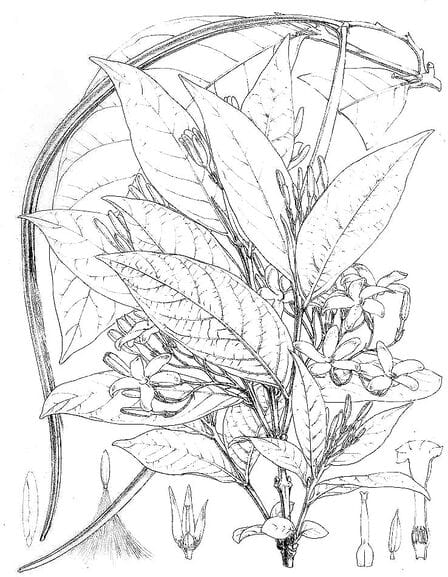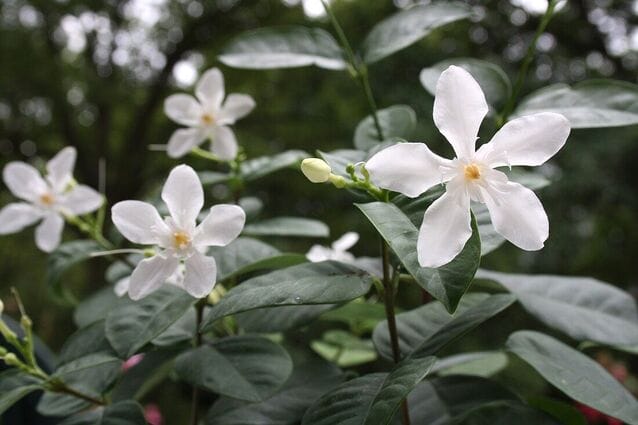Holarrhena, KutajaTellicherry, Easter treeKutaja, Kurchi, Kalinga, Vatsaka (Ayurveda) Indrayava (Seeds, Ayurveda); Teewaj, Kurchi (bark), Inderjao Talkh (seed) (Unani) Kudasappalai (Siddha) Dug Mo Nyung དུག་མོ་ཉུང༌ (Tibetan) |

|
 Holarrhena antidysenterica
Holarrhena antidysentericaIllustrations of the forest flora of North-West and Central India, Brandis, 1874
 Wrightia antidysenterica
Wrightia antidysenterica(Photo by Lionel Allorge) (Wikimedia)
Botanical name:
Holarrhena antidysenterica (syn. H. pubescens, Wrightia antidysenterica)
Two types of Indrayava are used in Ayurveda:
- Male or Bitter: Holarrhena antidysenterica
- Female or Sweet: Wrightia tinctoria
Parts used:
Seed; Bark
Temperature & Taste:
Cool, dry. Bitter, Pungent
Uses:
1. Clears Heat, Stops Leakage (bark; seed):
-Dysentery, ameobic Dysentery, Giardiasis, mucus colitis, Crohn’s diseases
-Diarrhea with mucus and blood (Charaka)
-considered the best single medicine for Diarrhea and Dysentery in classical Ayurvedic texts
2. Clears Liver Heat and Bile:
-Fever, especially with Diarrhea
-important for Bile disorders in Ayurveda and Tibetan Medicine
3. Clears Heat, Stops Bleeding:
-Bleeding from Heat
4. Kills Worms:
5. Promotes Milk
-increases milk quantity and quality (Ayurveda)
6. Externally:
-seeds applied to Malignant Ulcers, Leprosy, virulent skin diseases (Sushruta)
Dose:
Powder: 2–4 grams;
Decotion: 3–12 grams per day;
Tincture (1:3 alcohol 25%): 3–12 mls.
Comment:
This is the ‘Bitter’ type of Indrayava, the ‘Sweet’ being Wrightia tinctoria.
Correctives:
1. Cinnamon
2. Cardamon
3. Ginger
4. Salt
Substitutes:
1. Myrtus communis, Centaurea behen. Cheiranthus cheiri (Unani)
2. The bark of Ailanthus excelsa (Ayurveda)
3. Pycnostelma lateriflorum has been given as a source for the Tibetan Dug mo nyung by Russian sources. It is probably a local substitute.
4. Seed of Cynanchum thesioides is commonly used as a substitute in Mongolian Medicine, and the seeds of C. forrestii and C. komarovii are used in Tibetan Medicine. (see here)
5. The fruit of Forsythia suspense has also been used in Mongolian Medicine.
Main Combinations:
1. Diarrhea, Dysentery:
i. with mucus and blood, Holarrhena bark is decocted with Ginger (Charaka)
ii. Diarrhea with Blood, Holarrhena with Pomegranate rind mixed with Honey (Ayurveda, Ashtanga Hridaya)
iii. Holarrhena with Helicteres (Ayurveda)
iv. Holarrhena with Pomegranate rind, Belleric Myrobalan
v. Diarrhea, Holarrhena with Nigella, Madder
v. Diarrhea, Holarrhena with Cyperus rotundus, Pomegranate rind, Aegle
vi. Holarrhena with Madhuca flower, Gmelina bark, Raisin
vii. Holarrhena with Hemidesmus with Chebulic Myrobalan, Aegle
viii. Enterotoxic Diarrhea, Holarrhena with Vetiveria, Cinnamon, Jambul seed, Aegle fruit pulp (equal parts)
ix. Chronic Diarrhea, Holarrhena with Aconitum heterophyllum (Atis)
x. Malabsorption, Diarrhea, Dysentery, Holarrhena with Gmelina stem-bark, Madhuca, Woodfordia flowers, Raisins (as in Kutajarista)
2. Bloating, Colic, Wind, Holarrhena with Fennel, Cumin, asafetida
3. Hemorrhoids:
i. Holarrhena with Ginger, Long Pepper, Picrorrhiza
ii. Holarrhena with Selaginella. pulvinata, Withania, Embelia ribes, Tribulus (Tibetan Medicine)
iii. Holarrhena with Plumbago, Ginger, Chebulic Myrobalan
iv. Holarrhena seed with Solanum xanthocarpum, Tinospora, Plumbago, Caesalpinia crista bark, Gmelia arborea, Embelia, prepared as a medicinal Ghee (called Simhyamrta Ghrita)
4. Bile disorders, combine with Swertia and/or Gentian (Ayurveda, Tibetan Medicine)
5. Heat affecting the Internal Organs, with Aconitum heterophyllum, Geranium and Birthwort (Indra 4 of Tibetan Medicine)
6. Suppurative skin diseases, Holarrhena wtih Madder, Hemidesmus, Psoralea, Boerhaavia
Major Formulas:
Pushyanuga Churna (Ayurevda)
Kutajghan Vati (Holarrhena Tablets)
Golden 11 (Gser mdog 11) (Tibetan)
Clove 35 (Li shi so lnga).
Crystal Moon 37 (Zla shel so bdun) (Tibetan)
Cautions:
1. Contains pyrrolizidine alkaloids. Avoid overdose. Only used for short periods of time, maximum a few weeks.
2. Avoid in constipation.
3. Not used in those with Liver disease.
4. It has been banned in several countries including U.K.
Main Preparations used:
|
‘The Sanskrit names for this useful tree are very numerous, the best known are Kutaja and Kalioga, amongst others we may mention Girimallika, Vatsaka “cow tree,” Sakra sakhin “Indra’s tree,” and Sakrasana ” Indra’s food.” The tree is fabled to have sprung from the drops of amrita which, fell on the ground from the bodies of Rama’s monkeys, which were restored to life by Indra. The seeds are called in Sanskrit Indrayava, Bhadrayava, Vatsakavija, or SakrAvija, ” Indra’s seed.” The bark is one of the most important articles in the Hindu Materia Medica, and is described in the Nighantas as bitter, astringent, cold and digestive; a remedy for piles, dysentery, bile, leprosy and phlegmatic humours. Susruta says it is expectorant, an antidote to poisons, cures dysuria, urinary and skin diseases, checks nausea and vomiting, removes pruritus, improves the condition of bad ulcers, relieves pains of the stomach, and checks the derangement of the three humours, viz., phlegm, air and bile. The seeds are considered to be astringent, febrifuge and anthelmintic. Both bark and seeds are usually combined by Hindu physicians with a number of other medicines which are principally astringents, bitters and aromatics. As examples of such preparations we may mention the Kutajaleha or confection, and the Pathudya churna or compound powder of Chakradatta. In the Pradardni lauha the drug is combined with iron, but perhaps the most popular preparation is the Kutajdrishta or Kutaja wine of Sarangadhara, which is made in the following manner :— Take of fresh root bark, 12 1/2 seers, raisins, 6 1/4 seers, flowers of Bassia latifolia and bark of Gmeliina arborea of each 80 tolas; boil them together in 256 seers of water, till reduced to 64 seers, and strain. Then add flowers of Woodfordia floribunda 2 1/2 seers; treacle 12 1/2 seers, and let the mixture ferment for a month in a cool place (it is usually buried under the ground). Draw off and bottle. This preparation has an agreeable flavour, is not bitter, and is an excellent remedy in chronic dysentery and diarrhoea. Plasters and oils, containing Conessi bark combined with astringents and aromatics, are also used by the Hindus. They are applied over the. part of the abdomen which is most painful. Arabic and Persian writers describe the seeds under the name of Lisan-el-asafir-el-murr, and Zaban- |
i-gungishk-i-talk (bitter sparrow’s tongue) ; they consider them to be carminative and astringent, and prescribe them in chronic chest affections, such as asthma, also in colic and diuresis; besides this they attribute lithontriptic, tonic and aphrodisiac properties to them, and combined with honey and saffron make them into pessaries which are supposed to favour conception. We may mention incidentally that the use of medicated pessaries for this purpose is a common practice in India. They are also used after delivery. According to the Makhzan, the bark is the Tiwaj (tvac?) of Persian writers, which the author of the Tuhfat identifies with Talisfar, by some supposed to be the Indian bark used in dysentery by the Greek physicians under the name of [?]. The Portuguese physicians, Garcia and Christopher a Costa, describe the drug under the names of Coru, Curo, Cura and Corte de pala. Rheede, who calls the tree Codaga-pala, states that the bark is applied as a lip (plaster) in rheumatism, and than a hot decoction of it is used in toothache, and in the cure of bowel affections. Ainslie mentions the bark as having been lately admitted into the British Materia Medica, under the name of Conessi bark. Conessi bark, also known as Codaga pala, Corte de pala, and Tellicherry bark, enjoyed for a time considerable repute in Europe. It has however fallen into disrepute, principally, according to Sir Walter Elliot, who regards it as one of the most valuable medicinal products of India, from the comparatively inert bark of W. tinctoria having been confounded with it. Favourable reports of its use as a remedy in dysentery will be found in the Pharmacopoeia of India. For administration Mr. O. C. Dutt prefers a watery extract of the root bark, of which the average dose is about three grains in combination with half a grain or more of opium. Other European physicians have preferred the powdered bark, or a decoction made with 2 oz. of the bark to 2 pints of water, to be boiled down to one pint. The impure alkaloid (wrightine) is bitter, and has been used with some success as an antiperiodic, and in the treatment of dysentery occurring in aged persons and infants. It is sold by druggists in Calcutta’. (Pharmacographia Indica, Dymock, 1891) |
–Expanded therapeutic applications of Holarrhena antidysenterica: A review.
–Ethnopharmacology, phytochemistry, and biotechnological advances of family Apocynaceae: A review.
–Review of Holarrhena antidysenterica (L.) Wall. ex A. DC.: Pharmacognostic, Pharmacological, and Toxicological Perspective.
ANTIOXIDANT:
–Evaluation of antioxidative and antidiabetic activity of bark of holarrhena pubescens wall.
–In vitro antioxidant activity of Holarrhena antidysenterica Wall. methanolic leaf extract.
–Oxidative DNA damage preventive activity and antioxidant potential of plants used in Unani system of medicine.
ANTIBACTERIAL:
–Large Scale Screening of Ethnomedicinal Plants for Identification of Potential Antibacterial Compounds.
–Antibacterial efficacy of five medicinal plants against multidrug-resistant enteropathogenic bacteria infecting under-5 hospitalized children.
–Antibacterial properties of traditionally used Indian medicinal plants.
–Antibacterial and antidiarrhoeal effects of alkaloids of Holarrhena antidysenterica WALL.
–Antibacterial steroid alkaloids from the stem bark of Holarrhena pubescens.
ANTIBIOTIC RESISTANCE:
–Holarrhena antidysenterica Extract and Its Steroidal Alkaloid, Conessine, as Resistance-Modifying Agents Against Extensively Drug-Resistant Acinetobacter baumannii.
–Antibacterial efficacy of five medicinal plants against multidrug-resistant enteropathogenic bacteria infecting under-5 hospitalized children.
–Evaluation of anti-methicillin-resistant Staphylococcus aureus (MRSA) activity and synergy of some bioactive plant extracts.
MALARIA:
–Anti-malarial property of steroidal alkaloid conessine isolated from the bark of Holarrhena antidysenterica.
–Anti-malarial activity of Holarrhena antidysenterica and Viola canescens, plants traditionally used against malaria in the Garhwal region of north-west Himalaya.
IMMUNOMODULATOR:
–Immunomodulating agents of plant origin. I: Preliminary screening.
ANTINOCICEPTIVE:
–In vivo and in silico evaluation of antinociceptive activities of seed extract from the Holarrhena antidysenterica plant.
ACETYLCHOLINESTERASE INHIBITOR:
–Steroidal alkaloids from Holarrhena antidysenterica as acetylcholinesterase inhibitors and the investigation for structure-activity relationships.
DIARRHEA:
–Evaluation of antidiarrheal activity of ethanolic extract of Holarrhena antidysenterica seeds in rats.
–Antibacterial and antidiarrhoeal effects of alkaloids of Holarrhena antidysenterica WALL.
INHIBITS PERISTALSIS / GUT MOTILITY:
–Compounds with inhibitory activity on peristalsis from the seeds of Holarrhena antidysenterica.
–Pharmacological basis for the medicinal use of Holarrhena antidysenterica in gut motility disorders.
ULCERATIVE COLITIS:
–A Randomized Single Blind Parallel Group Study Comparing Monoherbal Formulation Containing Holarrhena Antidysenterica Extract with Mesalamine in Chronic Ulcerative Colitis Patients.
ANTHELMINTIC:
–Clinical studies on amoebiasis and giardiasis evaluating the efficacy of kutaja (holarrhena antidysenterica) in entamoeba histolytica cyst passers.
URINARY STONES:
–Studies on the in vitro and in vivo antiurolithic activity of Holarrhena antidysenterica.
DIABETES:
–Evaluation of antioxidative and antidiabetic activity of bark of holarrhena pubescens wall.
ANTI-MUTAGENIC:
–Antimutagenic activity of methanolic extracts of four ayurvedic medicinal plants.
CANCER:
–Induction of apoptosis in human bladder cancer cells by triterpenoids isolated from Holarrhena antidysenterica through differential reactive oxygen species generation.
–Role of radical quenching activity of dihydrocanaric acid in the treatment of cancer-experimental and theoretical.
–Methanol Extract of Holarrhena antidysenterica Inhibits the Growth of Human Oral Squamous Cell Carcinoma Cells and Osteoclastogenesis of Bone Marrow Macrophages.
–In vitro cytotoxic activity of leaves extracts of Holarrhena antidysenterica against some human cancer cell lines.
